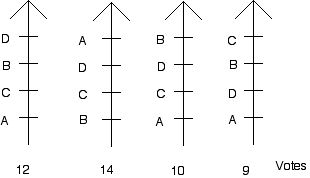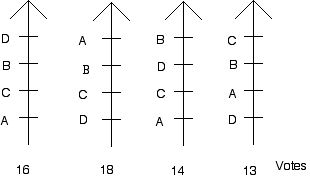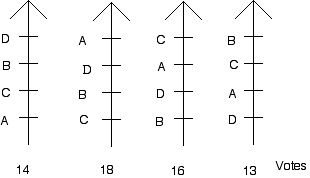
Review Final Examination (Spring 2007)
Honors Seminar (Humanities 320)
prepared by:
Joseph Malkevitch
Department of Mathematics and Computing
York College (CUNY)
Jamaica, New York 11451
Email: malkevitch@york.cuny.edu (for additions, suggestions, and corrections)
1. Decide the winner (if there is one) of the following elections using:
a. Plurality
b. Run-off
c. Sequential Run-off
d. Borda Count
e. Condorcet
f. Nanson
g. Coombs
(Note: Also, construct the vote matrix in each case)
I.

II

III

2. Determine the minimum winning coalitions and the Banzhaf power for the players in the following weighted voting games:
a. [11; 8, 4, 3]
b. [13; 8, 6, 5, 3]
c. [14; 8, 6, 5, 3]
d. [15; 8, 6, 5, 3]
3. For house sizes of:
a. h = 10
b. h = 11
c. h = 12
d. h = 100
use the methods:
i. Hamilton
ii. Webster
iii. Adams
iv. Jefferson
(Would it make any difference whether each state (party) is required to get at least 1 seat?)
to find the number of seats each state (party) would get if the populations (votes) involved are:
A = 10000
B = 8000
C = 6000
D = 1000
4. For the "estates" and claims below determine the amount that would be given to each claimant using:
a. Total equality of gain
b. Total equality of loss
c. Maimonides gain
d. Maimonides loss
e. Shapley
f. Proportionality
g. Contested garment rule
h. Aumann/Maschler
i. E = 210; A = 180, B = 120
ii. E = 240; A = 180, B = 120
iii. E = 270; A = 180, B = 120
iv. E = 100; A = 180, B = 120
v. E = 240; A = 180, B = 120, C = 100